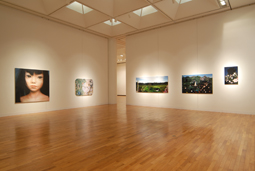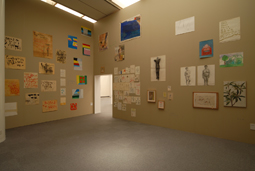 |
|
 |
In the Little Playground, installation view
photo by Tetsuo Ito |
|
In the Little Playground, installation view, room including the student work
photo by Tetsuo Ito |
|
|
"In the Little Playground: Hitsuda Nobuya and his surrounding students" is a set of dual concurrent exhibitions at the Aichi Prefectural Museum of Art and the Nagoya City Art Museum focusing on the work of artist and teacher Nobuya Hitsuda (b.1941) and his students, many of whom remain active as professional artists. Lovingly assembled, the exhibitions offer the viewer a glimpse inside the development of not only painting but work in a variety of media within Japan over the past 20 years.
A number of the most prominent Japanese contemporary artists practicing today studied in Nagoya and subsequently abroad, particularly in Germany. While the European influence is clear, it has always been something of a puzzlement as to where the vital ingredient originated that gave the work an appearance of its own, a contemporary Japanese aesthetic. What with the lack of writing on theory available in translation for those unable to read the Japanese language, as well as the general lack of critical discussion concerning younger Japanese artists, one had only the name and location of a particular school but no other textual basis for grasping the work. And while there were, and still are, points of correspondence between the painting of, say, Yoshitomo Nara and Kyoko Murase, it was always difficult to pinpoint something as an essential common characteristic.
After viewing the present exhibitions, each of which offers a generous selection of both students' and teacher's works within a historical context, it is easier to grasp this elusive quality. Hitsuda-sensei, as he is known, is an artist possessed of a widely varying array of cultural influences and interests. This is made explicit in an installation on view at the Aichi Prefectural Museum of Art. And while similar installations by his protégé Yoshitomo Nara can occasion a sense of voyeurism, Hitsuda is such an important -- albeit recent -- historical figure that the ephemera works as such: rather than a staged presence, it gives the viewer a sense of experiencing history first-hand. Also crucial and avoiding sentiment is a series of portraits executed by Hitsuda-sensei's students. Each painting incorporates elements of the artist's individual style fused with that of their former teacher.
What characterizes the body of paintings on view by Hitsuda is a tremendous sense of freedom and play within a given framework. Always first and foremost a painter, Hitsuda is able to experiment within the formal bounds of painting as such, utilizing abstract elements to represent a particular vision of the world. Favoring the landscape, Hitsuda graphs, grids, smears and splotches marks whose very randomness mirrors an arbitrariness which Hitsuda seems to sense in the painted image. Yet rather than despair, Hitsuda turns this openness into freedom, creating works brimming with inventive energy. This is echoed in the work of his students, particularly Hiroshi Sugito, who are (it would seem) playing first, representing second. And this is the crucial difference brought to light in the exhibitions: wherea Hitsuda represents first and plays within a focused project, his most successful students seem to experiment first, allowing their efforts to lead them towards representation.
This is not to deride Hitsuda, whose sense of joy in painting was a necessary step towards the creation of a truly contemporary Japanese aesthetic -- one defined by its openness towards playful possibility in painting and subsequently sculpture, photography and film. In a gesture towards the present and future of Japanese painting, Hitsuda executed collaborative work -- again, a mixed media piece created with Hiroshi Sugito stands out as the most obvious example -- whose fusion of "Painting" with a capital "P" and "Play" with a capital "P" prompt anticipation of the experience of an even younger generation of Japanese artists, those trained by Sugito and others who have now had a chance to experience the work of Hitsuda in its comprehensive and contextual completeness.
|